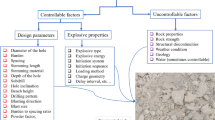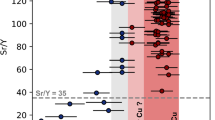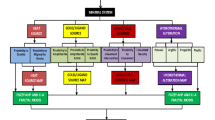Abstract
While gaining recognition, the Multiple-Point Geostatistics (MPS) method faces limitations in its application to mineral resource reserve estimation due to a lack of standardized parameter-setting practices. To address this challenge, this paper proposes an adaptive MPS parameter optimization framework based on optimization algorithms, which is implemented by a particle swarm algorithm (PSO) and direct sampling method (DS) and successfully applied to ore grade modeling. In the framework, PSO is employed to optimize the critical parameters of DS. To ensure accurate ore grade estimation, mean square error (MSE) is used to measure the performance of the DS model under the current parameter configuration. The PSO optimization algorithm is then used to minimize the MSE value and obtain the optimal DS model parameters. The effectiveness of the proposed method is validated using real ore deposit data. The original borehole data is randomly partitioned into training, testing, and validation sets. The training set is utilized for generating MPS training images, the testing set for determining optimal parameters, and the validation set for confirming the method's generalization and stability. The entire ore body is simulated in the final step, and simulation results are comprehensively compared. The experimental results show that the proposed method can automatically optimize the MPS parameters, avoiding the tedious process of manually adjusting the parameters and, at the same time, ensuring the accuracy and stability of the ore grade valuation.



















Similar content being viewed by others
Data availability
No datasets were generated or analysed during the current study.
Code availability
The code that support the findings of this study are available from the corresponding author upon reasonable request.
References
Afeni TB, Akeju VO, Aladejare AE (2021) A comparative study of geometric and geostatistical methods for qualitative reserve estimation of limestone deposit. Geosci Front 12(1):243–253. https://doi.org/10.1016/j.gsf.2020.02.019
Arpat GB (2005) Sequential simulation with patterns. Dissertation, Stanford University. https://doi.org/10.1016/j.chb.2015.02.010
Bai H, Mariethoz G (2021) A fast edge-based two-stage direct sampling method. Comput Geosci 150:104742. https://doi.org/10.1016/j.cageo.2021.104742
Bai H, Yang M, Mariethoz G (2023) A fast two part direct sampling method based on interpolation. Comput Geosci 175:105335. https://doi.org/10.1016/j.cageo.2023.105335
Caers J, Zhang T (2004) Multiple-point geostatistics: a quantitative vehicle for integrating geologic analogs into multiple reservoir models. AAPG Mem 80:383–394
Chen Q, Mariethoz G, Liu G et al (2018) Locality-based 3-D multiple-point statistics reconstruction using 2-D geological cross sections. Hydrol Earth Syst Sci 22(12):6547–6566. https://doi.org/10.5194/hess-22-6547-2018
Chen Q, Liu G, Ma X et al (2019) Conditional multiple-point geostatistical simulation for unevenly distributed sample data. Stoch Env Res Risk Assess 33:973–987. https://doi.org/10.1007/s00477-019-01671-5
Chen D, Chen Q, Cui Z et al (2023) SA-VAE: a novel approach for reservoir characterization based on variational auto-encoder and selective attention mechanism. Earth Sci Inform 1–19. https://doi.org/10.1007/s12145-023-01095-4
Comunian A, Renard P, Straubhaar J (2012) 3D multiple-point statistics simulation using 2D training images. Comput Geosci 40:49–65. https://doi.org/10.1016/j.cageo.2011.07.009
Cui Z, Chen Q, Liu G et al (2021) Multiple-point geostatistical simulation based on conditional conduction probability. Stoch Env Res Risk Assess 35(7):1355–1368. https://doi.org/10.1007/s00477-020-01944-4
Dagasan Y, Renard P, Straubhaar J et al (2018) Automatic parameter tuning of multiple-point statistical simulations for lateritic bauxite deposits. Minerals 8(5):220. https://doi.org/10.3390/min8050220
Dagasan Y, Erten O, Renard P, Straubhaar J, Topal E (2019) Multiple-point statistical simulation of the ore boundaries for a lateritic bauxite deposit. Stoch Env Res Risk Assess 33:865–878. https://doi.org/10.1007/s00477-019-01660-8
Ehteram M, Khozani ZS, Soltani-Mohammadi S, Abbaszadeh M (2023) The necessity of grade estimation. In: Estimating ore grade using evolutionary machine learning models. Springer, Singapore, pp 1–6. https://doi.org/10.1007/978-981-19-8106-7_1
Feng W, Yin Y, Zhang C et al (2019) A training image optimal selecting method based on composite correlation coefficient ranking for multiple-point geostatistics. J Petrol Sci Eng 179:292–311. https://doi.org/10.1016/j.petrol.2019.04.046
Gravey M, Mariethoz G (2020) QuickSampling v1. 0: a robust and simplified pixel-based multiple-point simulation approach. Geosci Model Dev 13(6):2611–2630. https://doi.org/10.5194/gmd-13-2611-2020
Guardiano FB, Srivastava RM (1993) Multivariate geostatistics: beyond bivariate moments. In: Soares A (ed) Geostatistics Tróia ’92. Springer Netherlands, Dordrecht, pp 133–144. https://doi.org/10.1007/978-94-011-1739-5_12
Holland JH (1975) Adaptation in natural and artificial systems: an introductory analysis with applications to biology, control and artificial intelligence. University Michigan Press, Ann Arbor
Honarkhah M, Caers J (2012) Direct pattern-based simulation of non-stationary geostatistical models. Math Geosci 44:651–672. https://doi.org/10.1007/s11004-012-9413-6
Hosseini S, Asghari O, Emery X (2021) An enhanced direct sampling (DS) approach to model the geological domain with locally varying proportions: Application to Golgohar iron ore mine. Iran Ore Geol Rev 139:104452. https://doi.org/10.1016/j.oregeorev.2021.104452
Jafrasteh B, Fathianpour N, Suárez A (2018) Comparison of machine learning methods for copper ore grade estimation. Comput Geosci 22:1371–1388. https://doi.org/10.1007/s10596-018-9758-0
Jordehi AR, Jasni J (2013) Parameter selection in particle swarm optimisation: a survey. J Exp Theor Artif Intell 25(4):527–542. https://doi.org/10.1080/0952813X.2013.782348
Kennedy J, Eberhart R (1995) Particle swarm optimization. Proceedings of ICNN'95-international conference on neural networks. IEEE 4:1942–1948. https://doi.org/10.1109/ICNN.1995.488968
Kessler TC, Comunian A, Oriani F et al (2013) Modeling fine-scale geological heterogeneity-examples of sand lenses in tills. Ground Water 51(5):692–705. https://doi.org/10.1111/j.1745-6584.2012.01015.x
Liu G, Fang H, Chen Q et al (2022) A feature-enhanced MPS approach to reconstruct 3D deposit models using 2D geological cross sections: A case study in the Luodang Cu deposit, Southwestern China. Nat Resour Res 31(6):3101–3120. https://doi.org/10.1007/s11053-022-10113-z
Mariethoz G, Caers J (2014) Multiple-point geostatistics: stochastic modeling with training models. Wiley, Hoboken
Mariethoz G, Renard P, Straubhaar J (2010) The direct sampling method to perform multiple‐point geostatistical simulations. Water Resour Res 46(11). https://doi.org/10.1029/2008WR007621
Meerschman E, Pirot G, Mariethoz G et al (2013) A practical guide to performing multiple-point statistical simulations with the Direct Sampling algorithm. Comput Geosci 52:307–324. https://doi.org/10.1016/j.cageo.2012.09.019
Peattie R, Dimitrakopoulos R (2013) Forecasting recoverable ore reserves and their uncertainty at Morila gold deposit, mali: an efficient simulation approach and future grade control drilling. Math Geosci 45:1005–1020. https://doi.org/10.1007/s11004-013-9478-x
Pirot G, Straubhaar J, Renard P (2015) A pseudo genetic model of coarse braided-river deposits. Water Resour Res 51(12):9595–9611. https://doi.org/10.1002/2015WR017078
Poli R, Kennedy J, Blackwell T (2007) Particle swarm optimization: An overview. Swarm Intell 1:33–57. https://doi.org/10.1007/s11721-007-0002-0
Rezaee H, Mariethoz G, Koneshloo M, Asghari O (2013) Multiple-point geostatistical simulation using the bunch-pasting direct sampling method. Comput Geosci 54:293–308. https://doi.org/10.1016/j.cageo.2013.01.020
Rumelhart DE, Hinton GE, Williams RJ (1986) Learning representations by back propagating errors. Nature 323(6088):533–536. https://doi.org/10.1038/323533a0
Saljoughi BS, Hezarkhani A (2018) A comparative analysis of artificial neural network (ANN), wavelet neural network (WNN), and support vector machine (SVM) data-driven models to mineral potential mapping for copper mineralizations in the Shahr-e-Babak region, Kerman. Iran Appl Geomatics 10(3):229–256. https://doi.org/10.1007/s12518-018-0229-z
Straubhaar J, Renard P, Mariethoz G et al (2011) An improved parallel multiple-point algorithm using a list approach. Math Geosci 43:305–328. https://doi.org/10.1007/s11004-011-9328-7
Strebelle S (2002) Conditional simulation of complex geological structures using multiple-point statistics. Math Geol 34:1–21. https://doi.org/10.1023/A:1014009426274
Tahmasebi P, Hezarkhani A, Sahimi M (2012) Multiple-point geostatistical modeling based on the cross-correlation functions. Comput Geosci 16(3):779–797. https://doi.org/10.1007/s10596-012-9287-1
Tahmasebi P, Sahimi M, Caers J (2014) MS-CCSIM: accelerating pattern-based geostatistical simulation of categorical variables using a multi-scale search in Fourier space. Comput Geosci 67:75–88. https://doi.org/10.1016/j.cageo.2014.03.009
Wang L, Yin Y, Feng W et al (2019) A training image optimization method in multiple-point geostatistics and its application in geological modeling. Pet Explor Dev 46(4):703–709. https://doi.org/10.1016/S1876-3804(19)60231-4
Wang X, Yu S, Li S et al (2022) Two parameter optimization methods of multi-point geostatistics. J Petrol Sci Eng 208:109724. https://doi.org/10.1016/j.petrol.2021.109724
Wang Z, Zuo R, Yang F (2023) Geological mapping using direct sampling and a convolutional neural network based on geochemical survey data. Math Geosci 55:1035–1058. https://doi.org/10.1007/s11004-022-10023-z
Yang F, Wu Y, Yang J et al (2016) Metallogenetic model for VMS type polymetallic copper deposits in the Ashele ore dense district of Altay, Xinjiang. Geotectonica et Metallogenia 40: 701–715. https://doi.org/10.16539/j.ddgzyckx.2016.04.006
Yin Z, Zuo C, MacKie EJ, Caers J (2022) Mapping high-resolution basal topography of West Antarctica from radar data using non-stationary multiple-point geostatistics (MPS-BedMappingV1). Geosci Model Dev 15(4):1477–1497. https://doi.org/10.5194/gmd-15-1477-2022
Zhang T, Switzer P, Journel A (2006a) Filter-based classification of training image patterns for spatial simulation. Math Geol 38:63–80. https://doi.org/10.1007/s11004-005-9004-x
Zhang XY, Xiao KY, Liu GS et al (2006b) The applied research of indicator Kriging method in visualized reserve computing of Ashele copper mine. J Jilin Univ (Earth Science Edition) 36(2):305–308. https://doi.org/10.13278/j.cnki.jjuese.2006.02.027
Zhang Z, Yang F, Li Q et al (2020) Mineral characteristics of Ashele Cu-Zn deposit of Xinjiang Altay and its geological significance. Mineral Deposits 39(5):905–925. https://doi.org/10.16111/j.0258-7106.2020.05.010
Funding
This work is supported by: The National Natural Science Foundation of China (No: 41972310 and 42172333), the Open Research Project of The Hubei Key Laboratory of Intelligent Geo-Information Processing (No: KLIGIP-2021B12), and Guizhou Science and Technology Project (No. [2022]ZD003).
Author information
Authors and Affiliations
Contributions
All authors contributed to the conception and design of the study. Z.L, X.Z, Q.C, and G.L were responsible for material preparation, data collection, and experimental validation. The first draft of the manuscript was written by Z.L, S.Y, and N.W. All authors reviewed and approved the final manuscript.
Corresponding author
Ethics declarations
Ethics approval
Not applicable.
Consent to participate
Not applicable.
Consent for publication
Not applicable.
Competing interests
The authors declare no competing interests.
Additional information
Communicated by: H. Babaie
Publisher's Note
Springer Nature remains neutral with regard to jurisdictional claims in published maps and institutional affiliations.
Rights and permissions
Springer Nature or its licensor (e.g. a society or other partner) holds exclusive rights to this article under a publishing agreement with the author(s) or other rightsholder(s); author self-archiving of the accepted manuscript version of this article is solely governed by the terms of such publishing agreement and applicable law.
About this article
Cite this article
Li, Z., Yi, S., Wang, N. et al. Adaptive direct sampling-based approach to ore grade modeling. Earth Sci Inform (2024). https://doi.org/10.1007/s12145-024-01297-4
Received:
Accepted:
Published:
DOI: https://doi.org/10.1007/s12145-024-01297-4




